17 Low Maintenance Palm Trees for Landscaping

Low-maintenance palm trees are ideal for transforming a front or backyard into a tropical oasis. Easy-care palm trees require minimal upkeep, making them perfect if you want to enjoy the beauty of palm trees with minimal effort. Low-maintenance palm trees are usually self-cleaning, require little water, or have a good tolerance to various soil types.
Low-maintenance palm trees for landscaping come in various types and sizes. Many small, easy-care palm trees have arching feathery fronds with long pointed leaflets. Other minimal-maintenance palms are multi-stemmed plants with rugged trunks and fan-like leaves.
Whether you opt for a tall palm tree to provide shade in a backyard or a low-growing palm tree to boost curb appeal in a front yard, low-maintenance palms create an exotic ambiance to an outdoor space.
This article provides descriptions and pictures of low-maintenance palm trees. You will find helpful tips on choosing the right palm trees and plants that require minimal upkeep and care.
What are Low-Maintenance Palm Trees?
The easiest palm trees to care for in a garden landscape are pineapple palms, king palms, parlor palms, and European fan palms.
Low maintenance palm trees are generally drought-tolerant, grow in various soil conditions, and require little fertilization. Other features include their self-cleaning habit and tolerance to high winds or salt spray.
When choosing low-maintenance palm trees, deciding which no-fuss features are important is vital. For example, some low-maintenance palms are excellent self-cleaners but require frequent watering. Other low-upkeep palm trees are better suited to coastal locations or colder climates. In some landscapes, slow-growing palms are the ideal solution.
Types of Low-Maintenance Palm Trees (with Pictures)
Let’s look in more detail at some of the best low-maintenance palms for landscaping front or backyards.
Canary Island Date Palm (Phoenix canariensis)
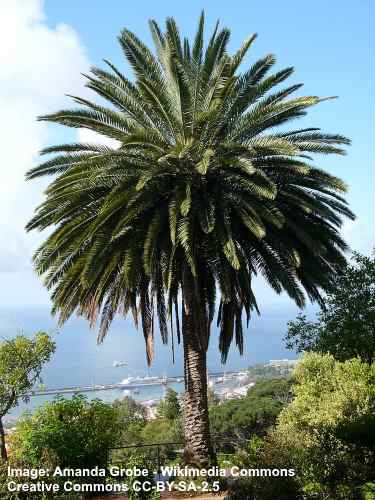
The canary island date palm tree is one of the easiest to care for due to its tolerance to salt, drought, and high winds. Additionally, this slow-growing palm thrives in full sun. The Canary Island date palm has deep green feathery fronds growing up to 15 ft. (4.5 m) long.
The low-maintenance Canary Island date palm is identified by its columnar trunk with diamond-shaped leaf bases, creamy-yellow flowers, and huge clusters of reddish-yellow palm fruits. It’s a popular outdoor palm tree for garden landscaping due to its tolerance for various soil conditions and coastal air. Its slow growth means it takes several years to reach its mature size.
- Mature Size: 40 to 60 ft. (12 – 18 m)
- USDA Hardiness Zones: 9 to 11
- Sun Exposure: Full sun
Date Palm (Phoenix dactylifera)
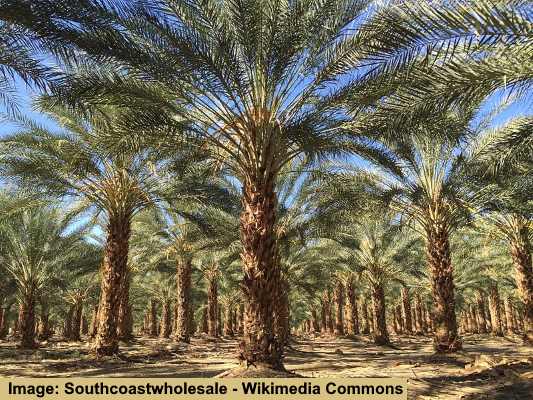
The date palm is a tall, low-maintenance palm tree for hot climates. The date palm is tolerant of a wide range of soil conditions, hot, dry climates, and drought periods. It’s identified by its waxy pinnate leaves with 150 sharp, stiff, pointed leaflets. It also produces huge clusters of edible juicy dates.
Slow-growing date palms grow up to 80 ft. (24 m) tall and thrive in coastal areas. Because it self-cleans, there is no need for regular pruning, eliminating a lot of maintenance work. The date palm can also produce golden brown, mahogany red, and yellow fruits if male and female palms are planted together.
The date palm is easily confused with the Canary Island date palm. However, Phoenix dactylifera is taller and less ornamental than Phoenix canariensis.
- Mature Size: 50 to 80 ft. (15 – 24 m)
- USDA Hardiness Zones: 9 to 11
- Sun Exposure: Full sun
Pygmy Date Palm (Phoenix roebelenii)
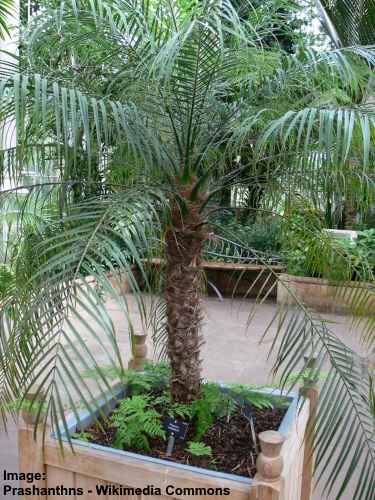
The pygmy date palm is a low-maintenance dwarf palm tree due to its slow growth, low stature, and lack of mess. The ornamental landscaping palm is characterized by its single rugged stem, long, bushy, silvery-gray pinnate fronds, creamy-white flowers, and edible drupes. The highly sought-after landscaping palm boosts curb appeal in subtropical landscaped gardens.
Pygmy date palms have the ornamental features of the related Canary Island and common date palms. You can grow the palm tree in containers outdoors or indoors. However, it thrives in the ground in most soil types.
Highly ornamental and requiring little care, the palm’s arching-drooping fronds are large and showy, almost concealing the spiky-looking trunk. If you want a tropical palm for your landscape, but the Canary Island date palm is too tall, the dwarf pygmy date palm is an ideal solution.
- Mature Size: 6 to 10 ft. (1.8 – 3 m)
- USDA Hardiness Zones: 9 to 11
- Sun Exposure: Full sun or partial shade
Foxtail Palm (Wodyetia bifurcata)
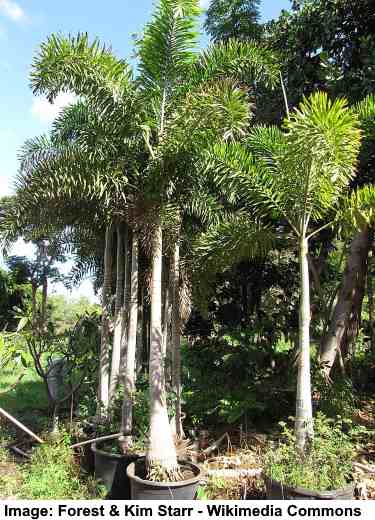
The foxtail palm is a stunning low-maintenance palm tree because of its self-cleaning habit and drought tolerance. The attractive features of this no-fuss palm are its long and arching bushy fronds resembling a fox’s tail, smooth gray cylindrical trunk, and green crown shaft. It also has clusters of white flowers and orange-red fruits.
The foxtail palm requires little care because the leaves die and drop without pruning. The decorative palms look attractive with their arching plumes of foliage atop tall branchless stems. The adaptable palm tree is relatively fast-growing in full sun, adding a tropical touch to any landscape.
- Mature Size: 20 to 30 ft. (6 – 9 m)
- USDA Hardiness Zones: 10 and 11
- Sun Exposure: Full sun
Piru Queen Palm (Syagrus romanzoffiana)
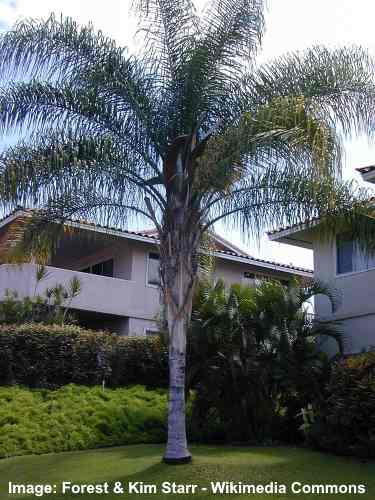
The piru queen palm is one of the most popular low-maintenance landscaping palm trees because it is self-cleaning, drought-tolerant, and easy to grow. Identifying features of the no-hassle palm are its smooth, gray trunk, gracefully arching feathery fronds 8 to 15 ft. (2.4 – 4.5 m) long, and clusters of creamy-white flowers.
Growing up to 70 ft. (21 m) tall, the piru queen palm tree can withstand temperatures as low as 25°F (-4°C). The sun-loving palm creates a lush, tropical look in garden landscapes without much effort. In addition, this palm tree produces small, orange fruits that add a touch of color to the landscape.
- Mature Size: 50 to 70 ft. (15 – 21 m)
- USDA Hardiness Zones: 9 to 11
- Sun Exposure: Full sun
Kentia Palm (Howea forsteriana)
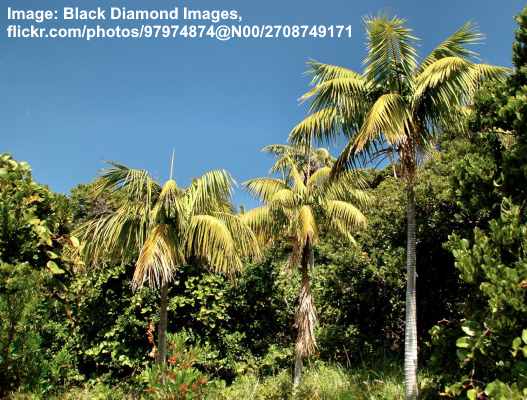
The kentia palm is one of the easiest palms to care for because it is tolerant of neglect. In partial shade, the attractive slow-growing palm tree tolerates temperatures up to 100°F (38°C). The Kentia palm is known for its long, graceful fronds arching elegantly from its slender trunk.
Growing outdoors in tropical regions, kentia palms are self-cleaning and thrive in shaded garden areas. Features of the palm tree are its 10 ft. (3 m) long fronds, showy clusters of white flowers, and oval-shaped coppery-brown or reddish fruits. It’s also a great palm tree for growing in containers outdoors or indoors.
Kentia palms are also low-maintenance houseplants because they need little care or attention. They thrive in indirect or filtered sunlight, making them excellent indoor palm plants for growing indoors with limited natural light.
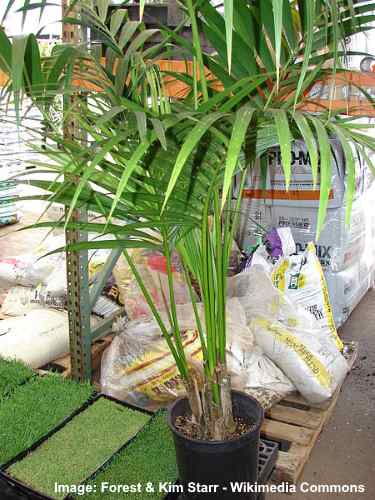
A kentia palm houseplant
- Mature Size: 10 to 30 ft. (3 to 9 m)
- USDA Hardiness Zones: 9 to 11
- Sun Exposure: Partial shade to full shade
Areca Palm (Dypsis lutescens)
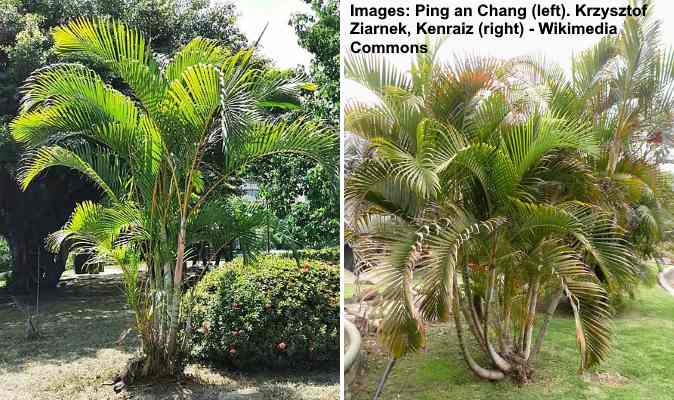
The areca palm is a no-fuss palm plant that requires little care because it thrives in partial shade and full sun and is self-cleaning. This popular landscaping plant is a medium-sized palm tree with feathery arching fronds. Its pinnate leaves grow 6 to 10 ft. (1.8 – 3 m) long.
Also called the butterfly palm or golden cane palm, the ornamental tropical tree is ideal for growing as an evergreen hedge, privacy screen, or specimen plant. Like the kentia palm, the areca palm is a non-nonsense indoor palm that requires indirect sunlight and occasional watering.
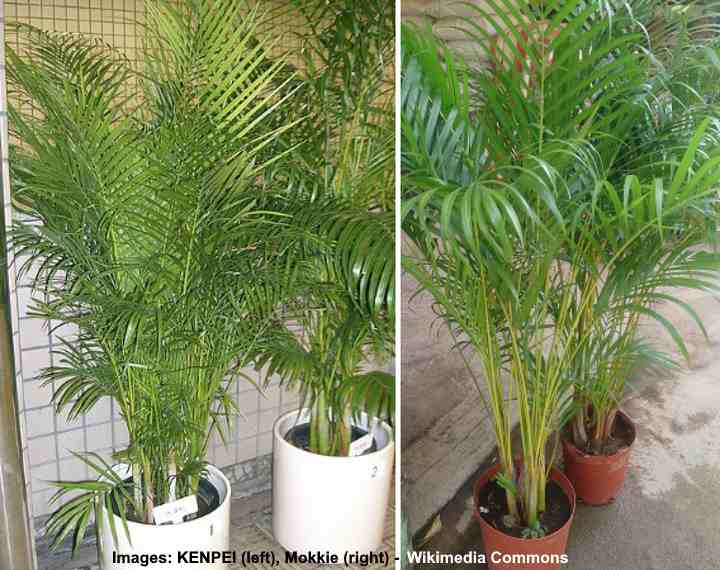
Areca palm houseplants
- Mature Size: 10 to 30 ft. (3 – 9 m)
- USDA Hardiness Zones: 10 and 11
- Sun Exposure: Full sun or partial shade
King Palm (Archontophoenix alexandrae)
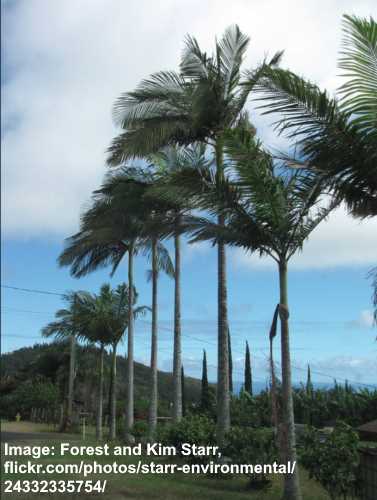
The king palm is an easy-care tall, majestic palm tree due to its self-cleaning habit and tolerance to drought and heat. The ornamental palm is identified by its slender, smooth, gray trunk, large, feather-like arching fronds creating a spreading crown, and huge clusters of red, yellow, and green flowers.
Low-maintenance, fast-growing king palms grow up to 100 ft. (30 m) tall. The palms are also known for their tolerance to various soil types and ability to withstand strong winds.
Although it requires little running, it requires regular watering in hot, sunny climates. However, it’s popular for landscaping in tropical and subtropical regions due to its elegant and regal appearance.
- Mature Size: 70 to 100 ft. (21 – 30 m)
- USDA Hardiness Zones: 10 to 11
- Sun Exposure: Full sun or partial shade
Ponytail Palm (Beaucarnea recurvata)
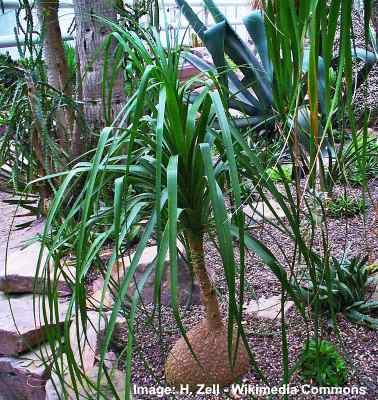
The ponytail palm is a distinctive short palm tree that requires little maintenance when growing in the garden. Identifying features of the easy-care palm tree are its long strap-like curled leaves, slender trunk with a swollen base, and clusters of small white flowers. The ponytail palm grows up to 16 ft. (5 m) tall.
One of the advantages of the ponytail palm is its easy care requirements. This low-maintenance plant is drought-tolerant and can thrive in a variety of conditions. It prefers bright, indirect light and well-draining soil.
The ponytail palm is often grown as an easy-care tropical houseplant. It thrives in low light and doesn’t require much care or water.
- Mature Size: 6 to 8 ft. (1.8 – 2.4 m)
- USDA Hardiness Zones: 10 and 11
- Sun Exposure: Full sun or light shade
Parlor Palm (Chamaedorea elegans)
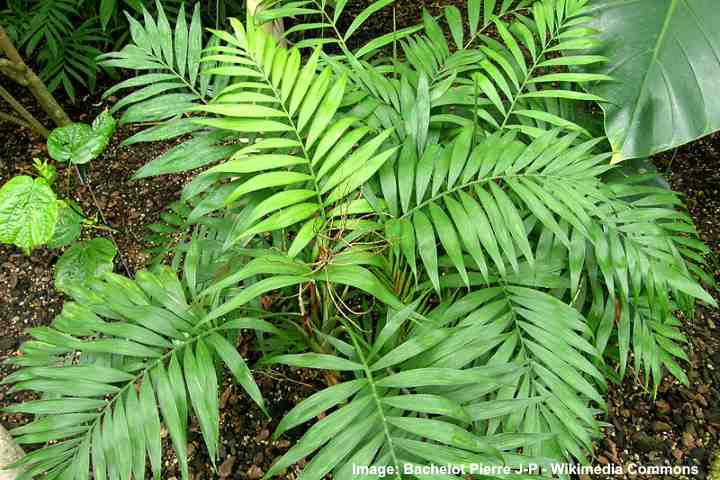
The parlor palm is a small, low-maintenance palm tree, ideal as a low-growing accent plant in tropical gardens. The palm species is identified by its slow growth, glossy feathery fronds growing on delicate stems, clusters of small white flowers, and tiny reddish-black fruits. These easy-care palm plants grow up to 8 ft. (2.4 m) tall in the ground.
Most people grow parlor palms as low-maintenance indoor potted palms. The hassle-free plants thrive in low-light conditions and require infrequent watering.
- Mature Size: 5 to 8 ft. (1.5 – 2.4 m)
- USDA Hardiness Zones: 10 to 12
- Sun Exposure: Filtered or indirect sunlight
Chinese Fan Palm (Livistona chinensis)
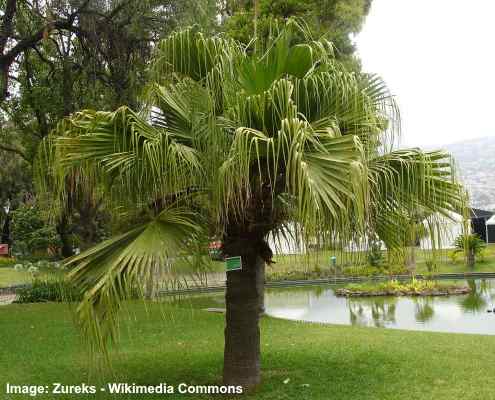
The Chinese fan palm is a popular low-maintenance landscaping palm tree because it self-prunes and is tolerant of drought, various soil types, and full sun. Identifying features of the palm are its large emerald-green fan-shaped fronds, weeping habit, huge clusters of creamy-white flowers, and grayish-blue fruits.
The Chinese fan palm can grow up to 30 ft. (9 m). This makes it an excellent choice for growing a relatively small palm tree in your front or backyard. Its exotic, tropical palmate leaves grow up to 5 ft. (1.5 m) in diameter. Easy to grow, it makes an eye-catching landscape specimen or container plant.
- Mature Size: 10 to 30 ft. (3 – 9 m)
- USDA Hardiness Zones: 9 to 11
- Sun Exposure: Full sun to partial shade
Majestic Palm (Ravenea rivularis)
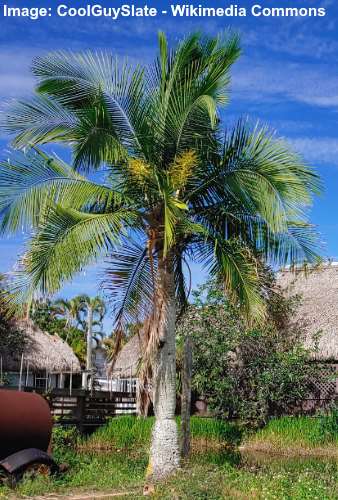
The majestic palm is one of the lowest maintenance palms to care for when growing it indoors. In a garden landscape, this palm species is identified by its upward-arching fronds with many long, thin, drooping leaflets. They thrive in humid climates where they withstand soggy, waterlogged soils.

Majestic palm houseplants
Majestic palms are popular palms for growing in containers indoors. Although the potted houseplants enjoy regular watering and some indirect sunlight, they also thrive in less-than-perfect conditions. And because of their slow growth, you only need to repot the plant every two years.
- Mature Size: 16 to 98 ft. (5 – 30 m)
- USDA Hardiness Zones: 9 to 11
- Sun Exposure: Full sun to partial shade
European Fan Palm (Chamaerops humilis)
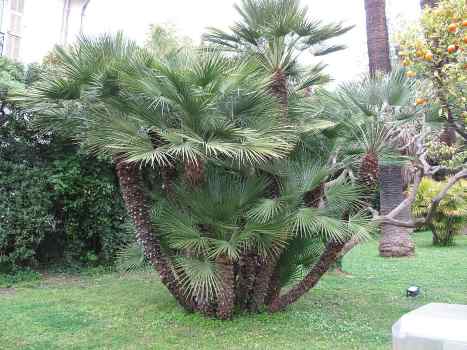
The European fan palm is an attractive, cold-hardy palm tree with few maintenance requirements. Although not self-cleaning, the palm only needs pruning once a year. However, once established, it is tolerant of drought, partial shade, wind, and cold weather. The exotic multi-stemmed palm tree grows up to 15 ft. (4.5 m) tall.
Known for its fan-shaped leaves and clustered trunks, the European fan has a shrub-like appearance. The landscaping plant has palmate, fan-shaped blue-green fronds at the end of 4 ft. (1.2 m) spiny petioles. Additionally, the shrubby palm has bright yellow flowers and yellow-orange to brown palm fruits in the fall.
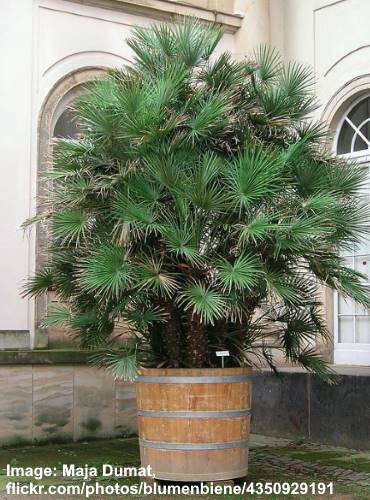
The European fan palm can be grown outdoors in a container
- Mature Size: 6 to 15 ft. (1.8 – 4.5 m)
- USDA Hardiness Zones: 9 to 11
- Sun Exposure: Full sun to partial shade
Christmas Palm (Adonidia merrillii)

The Christmas palm adds a tropical flare to low-maintenance yards thanks to its self-cleaning habit, pest-free nature, and tolerance for poor soils and salt spray. Also known as the Manila palm, the medium-sized palm tree has attractive arching feathery fronds, bright red fruits, and an exotic appearance.
The Christmas palm grows up to 25 ft. (7.5 m) and has a slender gray smooth trunk, bright green crown shaft, and wide, spreading crown. Its ten to 12 arching pinnate fronds measure 4 to 5 ft. (1.2 – 1.5 m) long. Its relatively short growth makes it a good landscaping alternative to the huge Florida royal palm (Roystonea regia).
- Mature Size: 20 to 25 ft. (6 – 7.6 m)
- USDA Hardiness Zones: 10 and 11
- Sun Exposure: Full sun to partial shade
Mexican Blue Palm (Brahea armata)
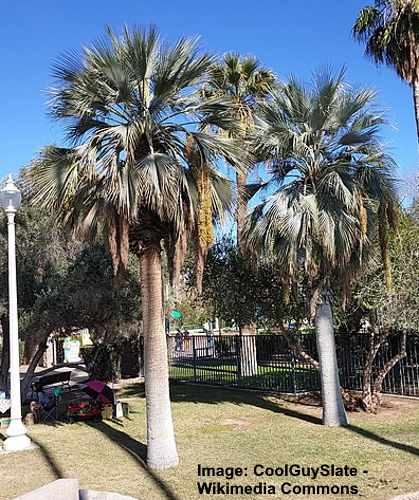
The Mexican blue palm is a stunning erect palm tree with few maintenance requirements because it’s drought-tolerant and self-cleaning. Its tolerance for drought, heat, full sun, and strong winds makes the tropical palm suited to desert-like climates. It’s also a cold-hardy palm during short spells.
Native to Baja California, this palm tree has spiky, fan-shaped blue-gray fronds with 20 to 40 lobes on the ends of 3 ft. (1 m) long petioles. The slow-growing palm produces creamy yellow flowers and golden yellow fruits that mature to black.
- Mature Size: 20 to 40 ft. (6 to 12 m)
- USDA Hardiness Zones: 9 to 11
- Sun Exposure: Full sun
Red Latan Palm (Latania lontaroides)
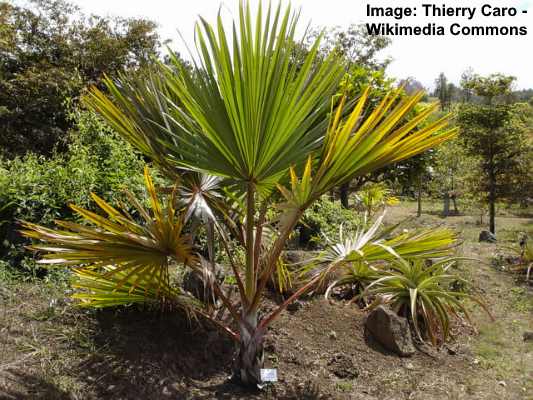
The red latan palm is a stunning slow-growing landscaping palm tree that is easy to care for because it’s salt, drought, and heat-tolerant, which makes it an excellent option for home gardens in coastal or dry areas.
The outstanding ornamental feature of the palm is its distinctive red leaves and petioles in the first years. Its blue-green foliage consists of large, fan-shaped leaves that can grow up to 6 ft. (1.8 m) wide. The palm has a smooth, gray, woody trunk with a slightly swollen base.
- Mature Size: 30 to 40 ft. (9 to 12 m)
- USDA Hardiness Zones: 9 to 11
- Sun Exposure: Full sun
Sylvester Palm (Phoenix sylvestris)
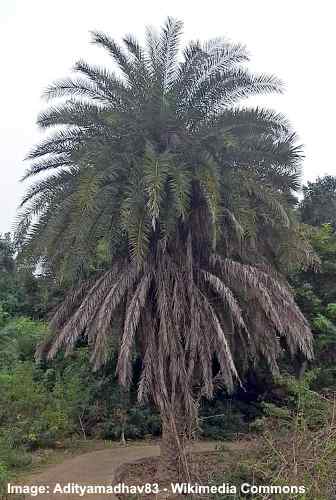
The Sylvester palm, or silver date palm, is a medium-sized palm tree with few maintenance needs in a residential landscape. The slow-growing palms have an attractive trunk covered in diamond-shaped leaf bases and arching pinnate silvery-gray fronds 10 ft. (3 m) long. Its tropical leafy crown grows up to 33 ft. (10 m) wide, giving it a graceful appearance.
Sylvester palms are resilient to drought, have a slow growth rate, and exhibit strong cold hardiness. They require a significant amount of sunlight to thrive but can also tolerate some shade. In addition, they are also relatively low-maintenance, requiring only the pruning of dead fronds to maintain their aesthetic.
The Sylvester palm tolerates a range of different soil types but grows best in sandy, well-drained soil.
- Mature Size: 13 to 50 ft. (4 – 15 m)
- USDA Hardiness Zones: 9 to 11
- Sun Exposure: Full sun to partial shade
Related articles:
